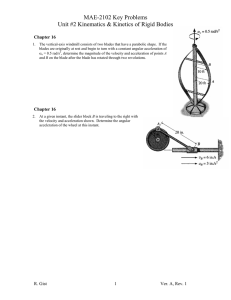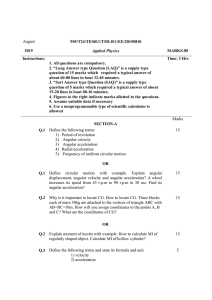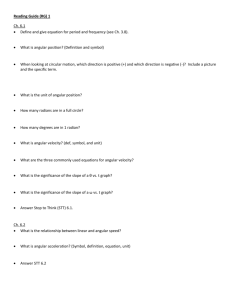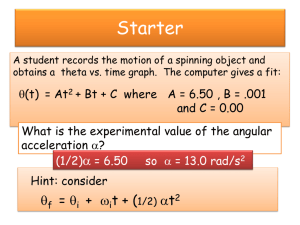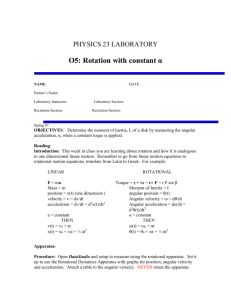Speeding Up and Slowing Down Rotationally Activity
advertisement
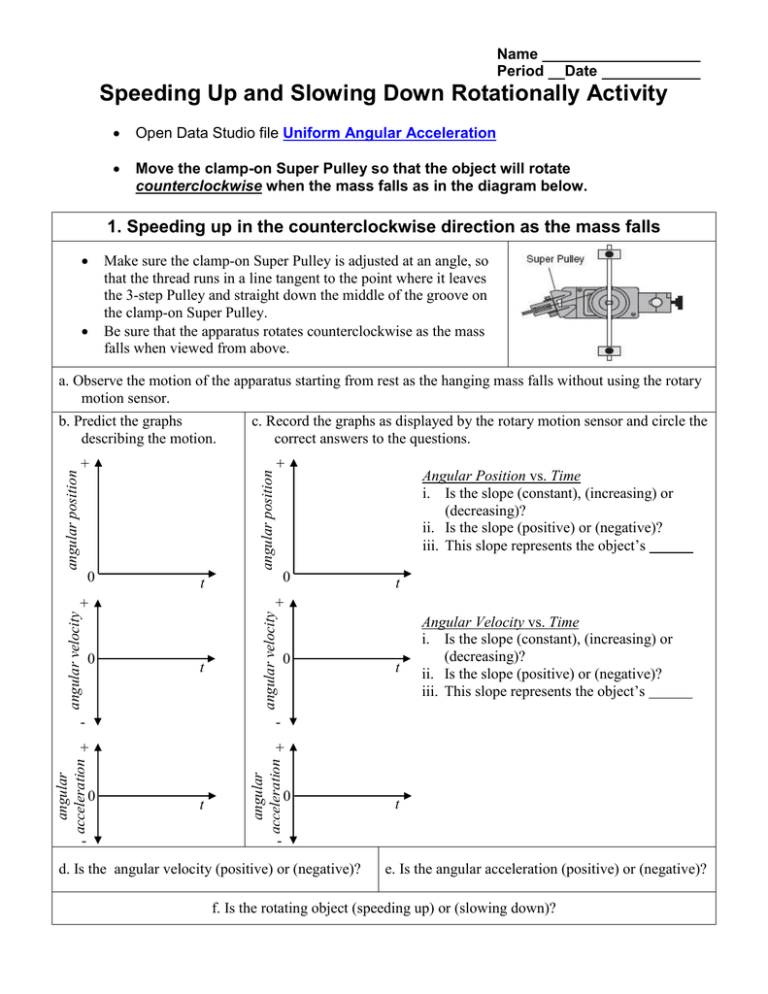
Name Period Date Speeding Up and Slowing Down Rotationally Activity Open Data Studio file Uniform Angular Acceleration Move the clamp-on Super Pulley so that the object will rotate counterclockwise when the mass falls as in the diagram below. 1. Speeding up in the counterclockwise direction as the mass falls Make sure the clamp-on Super Pulley is adjusted at an angle, so that the thread runs in a line tangent to the point where it leaves the 3-step Pulley and straight down the middle of the groove on the clamp-on Super Pulley. Be sure that the apparatus rotates counterclockwise as the mass falls when viewed from above. a. Observe the motion of the apparatus starting from rest as the hanging mass falls without using the rotary motion sensor. angular velocity 0 t t 0 - + + angular acceleration - - 0 Angular Position vs. Time i. Is the slope (constant), (increasing) or (decreasing)? ii. Is the slope (positive) or (negative)? iii. This slope represents the object’s t + + 0 + angular velocity 0 angular position + c. Record the graphs as displayed by the rotary motion sensor and circle the correct answers to the questions. t angular acceleration angular position b. Predict the graphs describing the motion. 0 t Angular Velocity vs. Time i. Is the slope (constant), (increasing) or (decreasing)? ii. Is the slope (positive) or (negative)? iii. This slope represents the object’s ? t - d. Is the angular velocity (positive) or (negative)? e. Is the angular acceleration (positive) or (negative)? f. Is the rotating object (speeding up) or (slowing down)? Speeding Up and Slowing Down Rotationally Activity page 2 2. Slowing down in the clockwise direction as the mass rises Make sure the clamp-on Super Pulley is adjusted at an angle, so that the thread runs in a line tangent to the point where it leaves the 3-step Pulley and straight down the middle of the groove on the clamp-on Super Pulley. Be sure that the apparatus rotates clockwise as the mass rises when viewed from above. a. Observe the motion of the apparatus slowing after an initial torque as the hanging mass rises without using the rotary motion sensor. Be sure to stop the apparatus when the hanging mass is at its highest point, before it moves back down. angular velocity + 0 angular position t + 0 t 0 - + + angular acceleration - - 0 t Angular Position vs. Time i. Is the slope (constant), (increasing) or (decreasing)? ii. Is the slope (positive) or (negative)? iii. This slope represents the object’s + angular velocity + 0 c. Record the graphs as displayed by the rotary motion sensor and circle the correct answers to the questions. t angular acceleration angular position b. Predict the graphs describing the motion. 0 t Angular Velocity vs. Time i. Is the slope (constant), (increasing) or (decreasing)? ii. Is the slope (positive) or (negative)? iii. This slope represents the object’s ? t - d. Is the angular velocity (positive) or (negative)? e. Is the angular acceleration (positive) or (negative)? f. Is the rotating object (speeding up) or (slowing down)? Speeding Up and Slowing Down Rotationally Activity page 3 Move the clamp-on Super Pulley so that the object will rotate clockwise when the mass falls as in the diagram below. 3. Speeding up in the clockwise direction as the mass falls Make sure the clamp-on Super Pulley is adjusted at an angle, so that the thread runs in a line tangent to the point where it leaves the 3-step Pulley and straight down the middle of the groove on the clamp-on Super Pulley. Be sure that the apparatus rotates clockwise as the mass falls when viewed from above. a. Observe the motion of the apparatus starting from rest as the hanging mass falls without using the rotary motion sensor. angular velocity + 0 angular position t + 0 t 0 - + + angular acceleration - - 0 t Angular Position vs. Time i. Is the slope (constant), (increasing) or (decreasing)? ii. Is the slope (positive) or (negative)? iii. This slope represents the object’s + angular velocity + 0 c. Record the graphs as displayed by the rotary motion sensor and circle the correct answers to the questions. t angular acceleration angular position b. Predict the graphs describing the motion. 0 t Angular Velocity vs. Time i. Is the slope (constant), (increasing) or (decreasing)? ii. Is the slope (positive) or (negative)? iii. This slope represents the object’s ? t - d. Is the angular velocity (positive) or (negative)? e. Is the angular acceleration (positive) or (negative)? f. Is the rotating object (speeding up) or (slowing down)? Speeding Up and Slowing Down Rotationally Activity page 4 4. Slowing down in the counterclockwise direction as the mass rises Make sure the clamp-on Super Pulley is adjusted at an angle, so that the thread runs in a line tangent to the point where it leaves the 3-step Pulley and straight down the middle of the groove on the clamp-on Super Pulley. Be sure that the apparatus rotates counterclockwise as the mass rises when viewed from above. a. Observe the motion of the apparatus slowing after an initial torque as the hanging mass rises without using the rotary motion sensor. Be sure to stop the apparatus when the hanging mass is at its highest point, before it moves back down. angular velocity 0 t + 0 + t 0 - + + angular acceleration - - 0 Angular Position vs. Time i. Is the slope (constant), (increasing) or (decreasing)? ii. Is the slope (positive) or (negative)? iii. This slope represents the object’s t + angular velocity 0 angular position + c. Record the graphs as displayed by the rotary motion sensor and circle the correct answers to the questions. t angular acceleration angular position b. Predict the graphs describing the motion. 0 t Angular Velocity vs. Time i. Is the slope (constant), (increasing) or (decreasing)? ii. Is the slope (positive) or (negative)? iii. This slope represents the object’s ? t - d. Is the angular velocity (positive) or (negative)? e. Is the angular acceleration (positive) or (negative)? f. Is the rotating object (speeding up) or (slowing down)? Speeding Up and Slowing Down Rotationally Activity page 5 As you hopefully noticed in the previous examples, whether the object is speeding up or slowing down can not be determined from only the sign of the angular acceleration. There is, thankfully, the same pattern as with linear uniform accelerated motion that can be used to determine whether the object is speeding up or slowing down. Complete the table below by circling the correct answers you saw in the previous examples. Angular Velocity Angular Acceleration Speeding Up or Slowing Down #1 (+) or (-) (+) or (-) (speeding up) or (slowing down) #2 (+) or (-) (+) or (-) (speeding up) or (slowing down) #3 (+) or (-) (+) or (-) (speeding up) or (slowing down) #4 (+) or (-) (+) or (-) (speeding up) or (slowing down) Do you see the pattern? The object is speeding up when the directions of the angular acceleration and of the motion (angular velocity) are (the same + +, - -) (different + -, - +) Circle the correct answer The cart is slowing down when the directions of the angular acceleration and of the motion ( angular velocity) are (the same + +, - -) (different + -, - +) Circle the correct answer As you do the last example, you should see this pattern continue. Speeding Up and Slowing Down Rotationally Activity page 6 5. Slowing down in the counterclockwise direction as the mass rises and then speeding up in the clockwise direction as the mass falls Make sure the clamp-on Super Pulley is adjusted at an angle, so that the thread runs in a line tangent to the point where it leaves the 3step Pulley and straight down the middle of the groove on the clamp-on Super Pulley. Be sure that the apparatus rotates counterclockwise as the mass rises when viewed from above. a. Observe the motion of the apparatus after an initial torque as the hanging mass rises and then falls without using the rotary motion sensor. 0 t c. Record the graphs as displayed by the rotary motion sensor and circle the correct answers to the questions. The dotted line represents the highest position of the mass. As the mass rises + i. Is the slope (constant), (increasing) or (decreasing)? ii. Is the slope (positive) or (negative)? As the mass falls i. Is the slope (constant), (increasing) or (decreasing)? 0 t ii. Is the slope (positive) or (negative)? angular position angular position b. Predict the graphs describing the motion. The dotted line represents the highest position of the mass. + iii. This slope represents the object’s ? 0 + t angular velocity angular velocity + 0 + + - 0 t angular acceleration - angular acceleration - 0 t Angular Velocity vs. Time i. Is the slope (constant), (increasing) or (decreasing)? ii. Is the slope (positive) or (negative)? iii. This slope represents the object’s ? t - d. Is the angular velocity (positive) or (negative)? e. Is the angular acceleration (positive) or (negative)? f. When the rotating object is slowing down the angular velocity is (positive) (negative) while the angular acceleration is (positive) (negative). g. However, when the rotating object is speeding up the angular velocity is (positive) (negative) while the angular acceleration is (positive) (negative).

